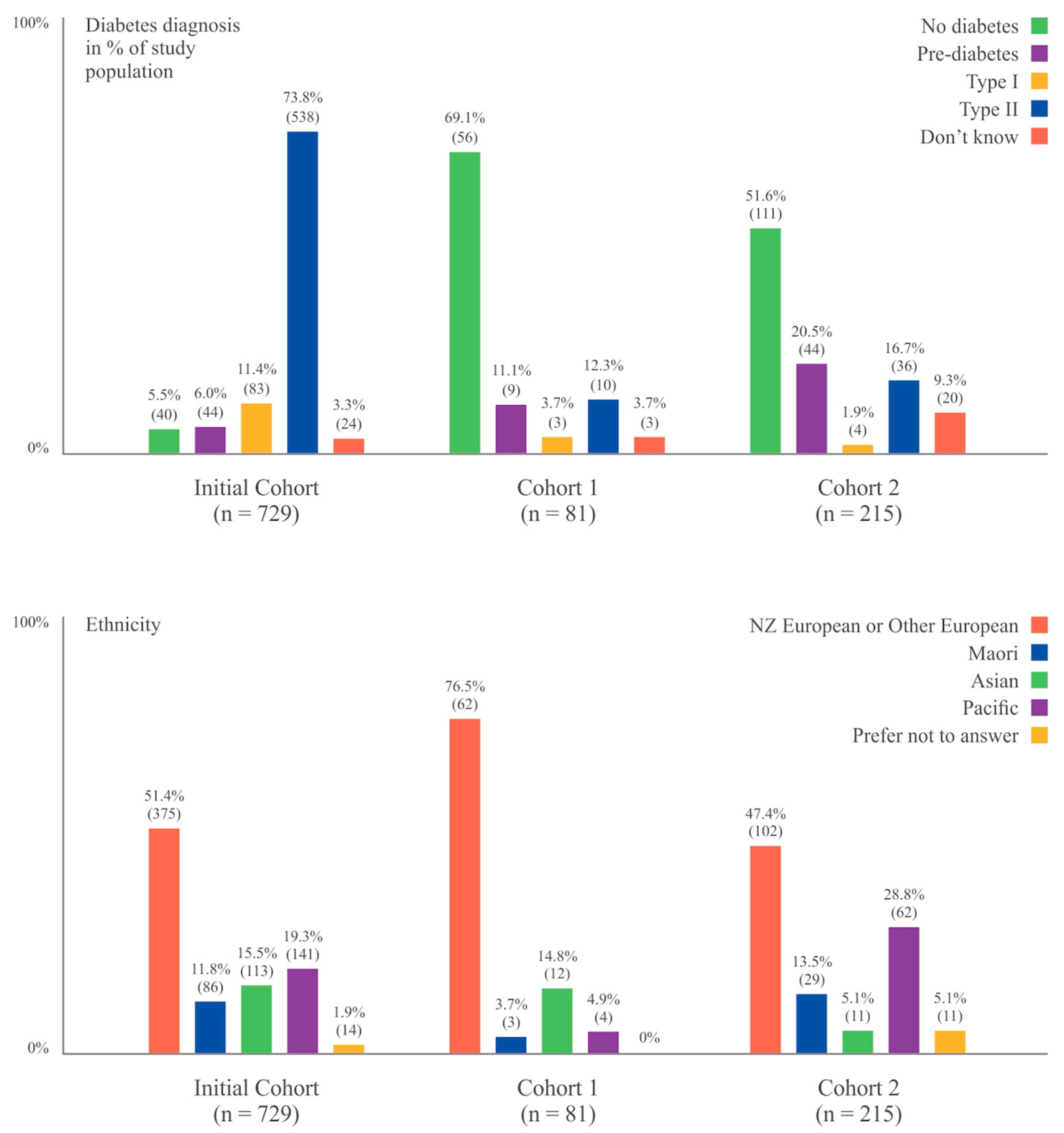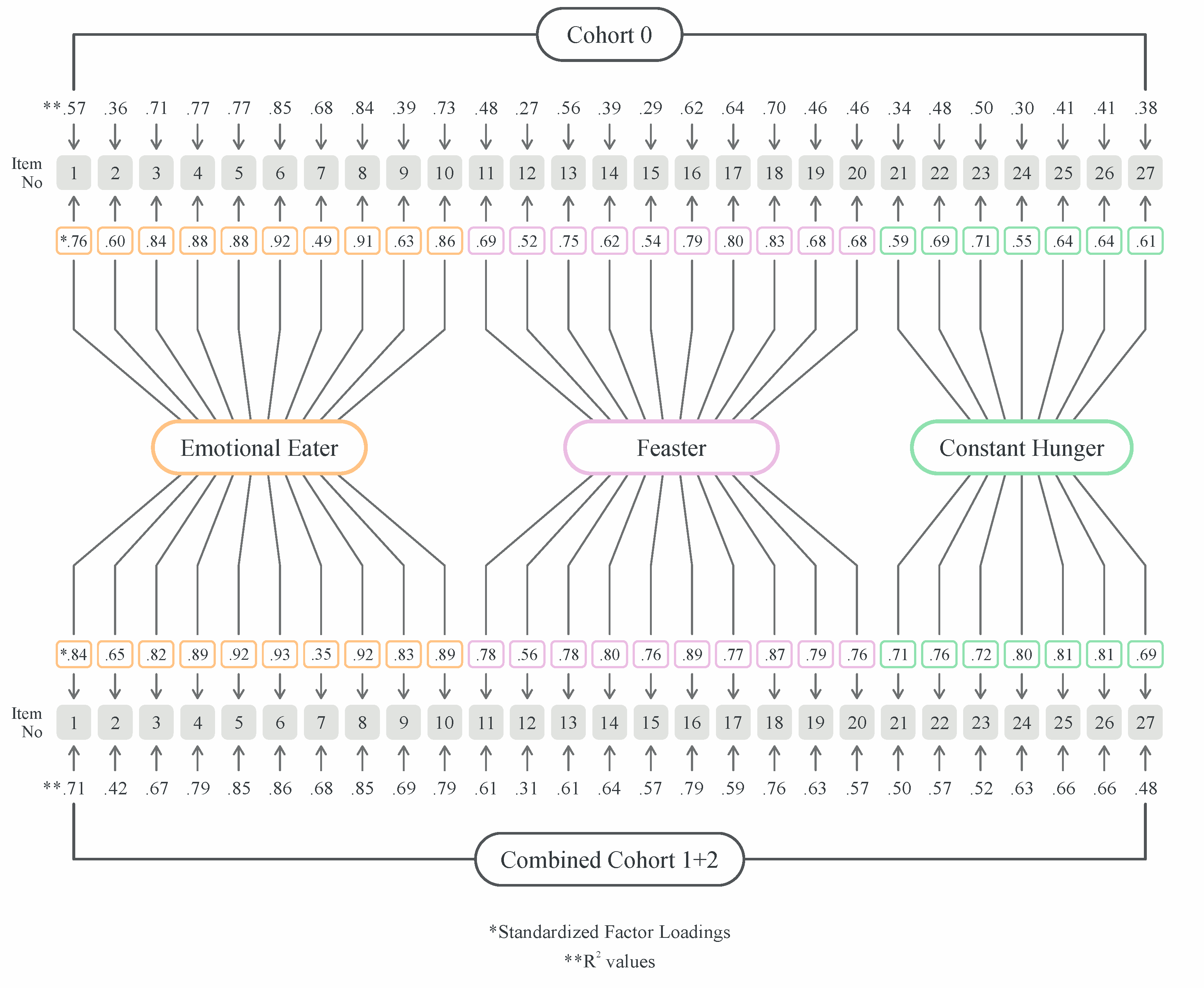Broader Validation of New Zealand Eating Behavior Questionnaire as Clinical Assessment Tool to Identify Actionable Eating Behavior Traits
Abstract
1. Introduction
2. Materials and Methods
2.1. Instrumentation
2.2. Population and Samples
2.2.1. Initial Cohort (Cohort 0)
2.2.2. Cohort 1
2.2.3. Cohort 2
2.3. Data Collection
2.4. Analysis
3. Results
3.1. Participants
3.2. Demographics
3.3. Confirmatory Factor Analysis
3.4. Classifying Dominant Eating Behavior Type of Participants
3.5. Test-Retest Reliability
3.6. Relationship Between Eating Behavior Trait and BMI
3.7. Self-Assessed Eating Behavior of Participants
3.8. Image-Based Questions
4. Discussion
5. Conclusions
Supplementary Materials
Author Contributions
Funding
Institutional Review Board Statement
Informed Consent Statement
Data Availability Statement
Acknowledgments
Conflicts of Interest
Abbreviations
| BES | Binge Eating Scale |
| CFI | Comparative Fit Index |
| CFA | Confirmatory Factor Analysis |
| CH | Constant Hunger |
| DEBQ | Dutch Eating Behavior Questionnaire |
| EB | Eating Behavior |
| EE | Emotional Eating |
| EFA | Exploratory Factor Analysis |
| F | Feasting |
| ICC | Intraclass Correlation Coefficients |
| KMO | Kaplan Meyer Olkin measure of sampling adequacy |
| NZ-EBQ | New Zealand Eating Behavior Questionnaire |
| RMSEA | Root-mean-square error of approximation |
| SRMR | Standardized root-mean-square residual |
| TFEQ | Three Factor Eating Questionnaire |
| TLI | Tucker-Lewis index |
| YFAS | Yale Food Addiction Scale |
References
- Blüher, M. Obesity: Global epidemiology and pathogenesis. Nat. Rev. Endocrinol. 2019, 15, 288–298. [Google Scholar] [CrossRef] [PubMed]
- Upadhyay, J.; Farr, O.; Perakakis, N.; Ghaly, W.; Mantzoros, C. Obesity as a disease. Med. Clin. N. Am. 2018, 102, 13–33. [Google Scholar] [CrossRef] [PubMed]
- MacLean, P.S.; Rothman, A.J.; Nicastro, H.L.; Czajkowski, S.M.; Agurs-Collins, T.; Courcoulas, A.P.; Ryan, D.H.; Bessesen, D.H.; Loria, C.M. The accumulating data to optimally predict obesity treatment (ADOPT) core measures project: Rationale and approach. Obesity 2018, 26 (Suppl. S2), S6–S15. [Google Scholar] [CrossRef] [PubMed]
- Roberts, C.A.; Christiansen, P.; Halford, J.C.G. Tailoring pharmacotherapy to specific eating behaviours in obesity: Can recommendations for personalised therapy be made from the current data? Acta Diabetol. 2017, 54, 715–725. [Google Scholar] [CrossRef]
- Cawley, J.; Biener, A.; Meyerhoefer, C.; Ding, Y.; Zvenyach, T.; Smolarz, B.G.; Ramasamy, A. Direct medical costs of obesity in the united states and the most populous states. J. Manag. Care Spec. Pharm. 2021, 27, 354–366. [Google Scholar] [CrossRef]
- Acosta, A.; Camilleri, M.; Abu Dayyeh, B.; Calderon, G.; Gonzalez, D.; McRae, A.; Rossini, W.; Singh, S.; Burton, D.; Clark, M.M. Selection of antiobesity medications based on phenotypes enhances weight loss: A pragmatic trial in an obesity clinic. Obesity 2021, 29, 662–671. [Google Scholar] [CrossRef]
- Camilleri, M.; Acosta, A. Gastrointestinal traits: Individualizing therapy for obesity with drugs and devices. Gastrointest. Endosc. 2016, 83, 48–56. [Google Scholar] [CrossRef]
- Dakin, C.; Finlayson, G.; Stubbs, R.J. Exploring the underlying psychological constructs of self-report eating behavior measurements: Toward a comprehensive framework. Psychol. Rev. 2024. [Google Scholar] [CrossRef]
- Hopkins, M.; Beaulieu, K.; Gibbons, C.; Halford, J.C.G.; Blundell, J.; Stubbs, J.; Finlayson, G. The Control of Food Intake in Humans. Available online: https://www.endotext.org (accessed on 17 November 2024).
- Gibbons, C.; Hopkins, M.; Beaulieu, K.; Oustric, P.; Blundell, J.E. Issues in measuring and interpreting human appetite (satiety/satiation) and its contribution to obesity. Curr. Obes. Rep. 2019, 8, 77–87. [Google Scholar] [CrossRef]
- Dakin, C.; Finlayson, G.; Stubbs, R.J. Investigating motivations to eat: Refining and validating a framework of eating behaviour traits in dieters and the general population. Appetite 2024, 201, 107543. [Google Scholar] [CrossRef]
- Blundell, J. Pharmacological approaches to appetite suppression. Trends Pharmacol. Sci. 1991, 12, 147–157. [Google Scholar] [CrossRef]
- Blundell, J.; de Graaf, C.; Hulshof, T.; Jebb, S.; Livingstone, B.; Lluch, A.; Mela, D.; Salah, S.; Schuring, E.; Van Der Knaap, H.; et al. Appetite control: Methodological aspects of the evaluation of foods. Obes. Rev. 2010, 11, 251–270. [Google Scholar] [CrossRef] [PubMed]
- Schmiedel, O.; Ivey, M.; Liu, A.; Murphy, R. The New Zealand eating behavior questionnaire—Validation study for a novel assessment tool to describe actionable eating behavior traits. Appetite 2023, 191, 107066. [Google Scholar] [CrossRef]
- Acosta, A.; Camilleri, M.; Shin, A.; Vazquez-Roque, M.I.; Iturrino, J.; Burton, D.; O’Neill, J.; Eckert, D.; Zinsmeister, A.R. Quantitative gastrointestinal and psychological traits associated with obesity and response to weight-loss therapy. Gastroenterology 2015, 148, 537–546.e4. [Google Scholar] [CrossRef] [PubMed]
- Stunkard, A.J.; Messick, S. The three-factor eating questionnaire to measure dietary restraint, disinhibition and hunger. J. Psychosom. Res. 1985, 29, 71–83. [Google Scholar] [CrossRef]
- Karlsson, J.; Persson, L.; Sjöström, L.; Sullivan, M. Psychometric properties and factor structure of the three-factor eating questionnaire (TFEQ) in obese men and women. results from the Swedish Obese Subjects (SOS) study. Int. J. Obes. 2000, 24, 1715–1725. [Google Scholar] [CrossRef] [PubMed]
- Löffler, A.; Luck, T.; Then, F.S.; Sikorski, C.; Kovacs, P.; Böttcher, Y.; Breitfeld, J.; Tönjes, A.; Horstmann, A.; Löffler, M.; et al. Eating behaviour in the general population: An analysis of the factor structure of the German version of the three-factor-eating-questionnaire (TFEQ) and its association with the body mass index. PLoS ONE 2015, 10, e0133977. [Google Scholar] [CrossRef]
- Anglé, S.; Engblom, J.; Eriksson, T.; Kautiainen, S.; Saha, M.T.; Lindfors, P.; Lehtinen, M.; Rimpelä, A. Three factor eating questionnaire-R18 as a measure of cognitive restraint, uncontrolled eating and emotional eating in a sample of young Finnish females. Int. J. Behav. Nutr. Phys. Act 2009, 6, 41. [Google Scholar] [CrossRef]
- de Lauzon, B.; Romon, M.; Deschamps, V.; Lafay, L.; Borys, J.M.; Karlsson, J.; Ducimetière, P.; Charles, M.A. The three-factor eating questionnaire-R18 is able to distinguish among different eating patterns in a general population. J. Nutr. 2004, 134, 2372–2380. [Google Scholar] [CrossRef]
- Gummer, T.; Roßmann, J.; Silber, H. Using instructed response items as attention checks in web surveys: Properties and implementation. Sociol. Methods Res. 2021, 50, 238–264. [Google Scholar] [CrossRef]
- Jensterle, M.; Rizzo, M.; Haluzík, M.; Janež, A. Efficacy of GLP-1 RA approved for weight management in patients with or without diabetes: A narrative review. Adv. Ther. 2022, 39, 2452–2467. [Google Scholar] [CrossRef]
- Davies, M.J.; Bergenstal, R.; Bode, B.; Kushner, R.F.; Lewin, A.; Skjøth, T.V.; Andreasen, A.H.; Jensen, C.B.; DeFronzo, R.A. Efficacy of liraglutide for weight loss among patients with type 2 diabetes: The SCALE diabetes randomized clinical trial. JAMA J. Am. Med. Assoc. 2015, 314, 687–699. [Google Scholar] [CrossRef]
- Comrey, A.L.; Lee, H.B. A First Course in Factor Analysis, 2nd ed.; Erlbaum: Hillsdale, NJ, USA, 1992. [Google Scholar]
- Landis, J.R.; Koch, G.G. The measurement of observer agreement for categorical data. Biometrics 1977, 33, 159–174. [Google Scholar] [CrossRef]
- Koo, T.K.; Li, M.Y. A guideline of selecting and reporting intraclass correlation coefficients for reliability research. J. Chiropr. Med. 2016, 15, 155–163. [Google Scholar] [CrossRef]
- Schulte, E.M.; Gearhardt, A.N. Development of the modified yale food addiction scale version 2.0. Eur. Eat. Disord. Rev. 2017, 25, 302–308. [Google Scholar] [CrossRef]
- Blundell, J.E.; Lawton, C.L.; Hill, A.J. Mechanisms of appetite control and their abnormalities in obese patients. Horm. Res. 1993, 39 (Suppl. S3), 72–76. [Google Scholar] [CrossRef]
- Hunot, C.; Fildes, A.; Croker, H.; Llewellyn, C.H.; Wardle, J.; Beeken, R.J. Appetitive traits and relationships with BMI in adults: Development of the adult eating behaviour questionnaire. Appetite 2016, 105, 356–363. [Google Scholar] [CrossRef]
- van Strien, T. Causes of emotional eating and matched treatment of obesity. Curr. Diab. Rep. 2018, 18, 35–38. [Google Scholar] [CrossRef]
- Konttinen, H.; van Strien, T.; Männistö, S.; Jousilahti, P.; Haukkala, A. Depression, emotional eating and long-term weight changes: A population-based prospective study. Int. J. Behav. Nutr. Phys. Act. 2019, 16, 28. [Google Scholar] [CrossRef] [PubMed]
- Van Strien, T.; Frijters, J.E.R.; Bergers, G.P.A.; Defares, P.B. The Dutch Eating Behavior Questionnaire (DEBQ) for assessment of restrained, emotional, and external eating behavior. Int. J. Eat. Disord. 1986, 5, 295–315. [Google Scholar] [CrossRef]
- Nagl, M.; Hilbert, A.; de Zwaan, M.; Braehler, E.; Kersting, A. The German version of the dutch eating behavior questionnaire: Psychometric properties, measurement invariance, and population-based norms. PLoS ONE 2016, 11, e0162510. [Google Scholar] [CrossRef]
- Barrada, J.R.; van Strien, T.; Cebolla, A. Internal structure and measurement invariance of the Dutch eating behavior questionnaire (DEBQ) in a (nearly) representative Dutch community sample. Eur. Eat. Disord. Rev. 2016, 24, 503–509. [Google Scholar] [CrossRef] [PubMed]
- Acosta, A.; Cifuentes, L.; Anazco, D.; O’Connor, T.; Hurtado, M.; Ghusn, W.; Campos, A.; Fansa, S.; McRae, A.; Madhusudhan, S.; et al. Unraveling the variability of human satiation: Implications for precision obesity management. Res. Sq. 2024. [Google Scholar] [CrossRef]
- Caroleo, M.; Primerano, A.; Rania, M.; Aloi, M.; Pugliese, V.; Magliocco, F.; Fazia, G.; Filippo, A.; Sinopoli, F.; Ricchio, M. A real world study on the genetic, cognitive and psychopathological differences of obese patients clustered according to eating behaviours. Eur. Psychiatry 2018, 48, 58–64. [Google Scholar] [CrossRef]
- Gormally, J.; Black, S.; Daston, S.; Rardin, D. The assessment of binge eating severity among obese persons. Addict. Behav. 1982, 7, 47–55. [Google Scholar] [CrossRef]
- Beck, A.T.; Ward, C.H.; Mendelson, M.; Mock, J.; Erbaugh, J. An inventory for measuring depression. Arch. Gen. Psychiatry 1961, 4, 561–571. [Google Scholar] [CrossRef]
- Segura-García, C.; Aloi, M.; Rania, M.; Ciambrone, P.; Palmieri, A.; Pugliese, V.; Moruno, A.J.R.; De Fazio, P. Ability of EDI-2 and EDI-3 to correctly identify patients and subjects at risk for eating disorders. Eat. Behav. Int. J. 2015, 19, 20–23. [Google Scholar] [CrossRef]
- Dakin, C.; Finlayson, G.; Stubbs, R.J. Can eating behaviour traits be explained by underlying, latent factors? An exploratory and confirmatory factor analysis. Appetite 2024, 195, 107202. [Google Scholar] [CrossRef]
- Bryant, E.J.; Rehman, J.; Pepper, L.B.; Walters, E.R. Obesity and eating disturbance: The role of TFEQ restraint and disinhibition. Curr. Obes. Rep. 2019, 8, 363–372. [Google Scholar] [CrossRef] [PubMed]
- Dakin, C.A.; Finlayson, G.; Horgan, G.; Palmeira, A.L.; Heitmann, B.L.; Larsen, S.C.; Sniehotta, F.F.; Stubbs, R.J. Exploratory analysis of reflective, reactive, and homeostatic eating behaviour traits on weight change during the 18-month NoHoW weight maintenance trial. Appetite 2023, 189, 106980. [Google Scholar] [CrossRef] [PubMed]
- Dakin, C.; Beaulieu, K.; Hopkins, M.; Gibbons, C.; Finlayson, G.; Stubbs, R.J. Do eating behavior traits predict energy intake and body mass index? A systematic review and meta-analysis. Obes. Rev. 2023, 24, e13515. [Google Scholar] [CrossRef]
- Koning, E.; Vorstman, J.; McIntyre, R.S.; Brietzke, E. Characterizing eating behavioral phenotypes in mood disorders: A narrative review. Psychol. Med. 2022, 52, 2885–2898. [Google Scholar] [CrossRef]
- Mills, J.G.; Thomas, S.J.; Larkin, T.A.; Pai, N.B.; Deng, C. Problematic eating behaviours, changes in appetite, and weight gain in major depressive disorder: The role of leptin. J. Affect. Disord. 2018, 240, 137–145. [Google Scholar] [CrossRef]
- Chial, H.J.; Camilleri, C.; Delgado-Aros, S.; Burton, D.; Thomforde, G.; Ferber, I.; Camilleri, M. A nutrient drink test to assess maximum tolerated volume and postprandial symptoms: Effects of gender, body mass index and age in health. Neurogastroenterol. Motil. 2002, 14, 249–253. [Google Scholar] [CrossRef]
- Bettadapura, S.; Dowling, K.; Jablon, K.; Al-Humadi, A.W.; le Roux, C.W. Changes in food preferences and ingestive behaviors after glucagon-like peptide-1 analog treatment: Techniques and opportunities. Int. J. Obes. 2024. [Google Scholar] [CrossRef]



| Initial Cohort (n = 729) | Cohort 1 (n = 81) | Cohort 2 (n = 215) | |
|---|---|---|---|
| Age category | |||
| 18–30 years | 12 (1.6%) | 14 (17.3%) | 21 (9.8%) |
| 31–45 years | 98 (13.4%) | 17 (21.0%) | 88 (40.9%) |
| 46–60 years | 244 (33.5%) | 33 (40.7%) | 76 (35.3%) |
| 61–75 years | 300 (41.1%) | 14 (17.3%) | 28 (13.0%) |
| 76 years or older | 75 (10.3%) | 3 (3.7%) | 2 (0.9%) |
| Gender | |||
| Male | 415 (56.9%) | 26 (32.1%) | 48 (22.3%) |
| Female | 313 (42.9%) | 55 (67.9%) | 164 (76.3%) |
| Non-binary | 1 (0.1%) | 0 (0.0%) | 3 (1.4%) |
| Highest education completed | |||
| Primary school | 22 (3.0%) | 1 (1.2%) | 12 (5.6%) |
| Secondary school | 410 (56.2%) | 26 (32.1%) | 127 (59.1%) |
| Bachelor degree | 207 (28.4%) | 43 (53.1%) | 65 (30.2%) |
| Master or doctoral degree | 90 (12.3%) | 11 (13.6%) | 11 (5.1%) |
| Perception of current weight | |||
| Underweight | 20 (2.7%) | 0 (0.0%) | 0 (0.0%) |
| Neither underweight nor overweight | 214 (29.4%) | 11 (13.6%) | 12 (5.6%) |
| Overweight | 370 (50.7%) | 45 (55.6%) | 48 (22.3%) |
| Very overweight | 125 (17.1%) | 25 (30.9%) | 155 (72.1%) |
| Want to lose weight | 556 (76.3%) | 72 (88.9%) | 209 (97.2%) |
| Currently taking prescription weight loss medication | 15 (2.1%) | 31 (38.3%) | 19 (8.8%) |
| Current weight (kg) | Mean (95% CI) | Mean (95% CI) | Mean (95% CI) |
| 97.2 (95.2–99.1) | 102.0 (96.0–108.9) | 139.3 (133.6–145.0) |
| Classification of Eating Behavior | Original Model | New Model | % Change |
|---|---|---|---|
| Emotional eater | 190 (26.1%) | 192 (26.3%) | +1.0% |
| Feaster | 162 (22.2%) | 155 (21.2%) | −4.3% |
| Constant hunger | 322 (44.2%) | 312 (42.8%) | −3.1% |
| Unassigned | 55 (7.5%) | 70 (9.6%) | +27.3% |
| No. | Item | ICC | 95% CI |
|---|---|---|---|
| 1 | When I feel anxious, worried, or tense, I find myself eating. | 0.79 | 0.63–0.88 |
| 2 | I can get moody when I can’t have certain foods I crave, and I feel bad or empty if I deny myself having them. | 0.60 | 0.36–0.77 |
| 3 | When I feel lonely, I console myself by eating. | 0.67 | 0.45–0.81 |
| 4 | When I feel emotionally upset or when someone lets me down, I have a strong desire to reward myself with food. | 0.90 | 0.82–0.95 |
| 5 | I eat when I’m down. | 0.84 | 0.71–0.91 |
| 6 | When I feel sad, blue, or disappointed, I often overeat and/or have the desire to eat. | 0.89 | 0.80–0.94 |
| 8 | I have a desire to eat when things have gone wrong. | 0.89 | 0.80–0.94 |
| 9 | When you are going through a stressful or upsetting time what happens to your eating? | 0.77 | 0.60–0.87 |
| 10 | I know that I’m an emotional eater. | 0.92 | 0.81–0.96 |
| 11 | During a meal, I have no sense of being full and can’t stop until I’m really stuffed. | 0.53 | 0.26–0.73 |
| 12 | When I’m preparing food I cannot stop tasting and eating while preparing. | 0.72 | 0.53–0.84 |
| 13 | Are you able to stop eating whenever you want? | 0.50 | 0.21–0.70 |
| 14 | I can get hungry again in a few hours, even if I just had a large meal. | 0.53 | 0.26–0.73 |
| 15 | Do you eat large portion sizes? | 0.50 | 0.22–0.71 |
| 16 | When I’m hungry I lose control over how much I eat and find it hard to stop eating. | 0.69 | 0.48–0.83 |
| 17 | Do you feel a sensation of fullness during eating? | 0.48 | 0.19–0.69 |
| 18 | Once I start eating, I have trouble stopping. | 0.68 | 0.47–0.82 |
| 19 | How difficult would it be for you to stop eating halfway through a meal (not finish your plate)? | 0.63 | 0.40–0.79 |
| 20 | How difficult is it for you not to overeat at a large tasty meal? | 0.78 | 0.61–0.88 |
| 21 | I have cravings or urges to eat snacks after supper for before bedtime. | 0.71 | 0.52–0.84 |
| 22 | When I see a real delicacy, I often get so hungry that I have to eat right away. | 0.62 | 0.38–0.78 |
| 23 | Whenever I have a food craving, I keep on thinking about eating until I actually eat the food. | 0.46 | 0.18–0.68 |
| 24 | How often do you feel so hungry that you just have to eat something? | 0.65 | 0.42–0.80 |
| 25 | I am always hungry enough to eat at any time. | 0.81 | 0.67–0.90 |
| 26 | If I haven’t eaten for a while I find it very hard to resist my hunger. | 0.81 | 0.67–0.90 |
| 27 | I have a habit of eating too much at night and I’m not hungry in the morning. | 0.69 | 0.48–0.82 |
Disclaimer/Publisher’s Note: The statements, opinions and data contained in all publications are solely those of the individual author(s) and contributor(s) and not of MDPI and/or the editor(s). MDPI and/or the editor(s) disclaim responsibility for any injury to people or property resulting from any ideas, methods, instructions or products referred to in the content. |
© 2025 by the authors. Licensee MDPI, Basel, Switzerland. This article is an open access article distributed under the terms and conditions of the Creative Commons Attribution (CC BY) license (https://creativecommons.org/licenses/by/4.0/).
Share and Cite
Schmiedel, O.; Ivey, M.; Murphy, R. Broader Validation of New Zealand Eating Behavior Questionnaire as Clinical Assessment Tool to Identify Actionable Eating Behavior Traits. Nutrients 2025, 17, 1049. https://doi.org/10.3390/nu17061049
Schmiedel O, Ivey M, Murphy R. Broader Validation of New Zealand Eating Behavior Questionnaire as Clinical Assessment Tool to Identify Actionable Eating Behavior Traits. Nutrients. 2025; 17(6):1049. https://doi.org/10.3390/nu17061049
Chicago/Turabian StyleSchmiedel, Ole, Melissa Ivey, and Rinki Murphy. 2025. "Broader Validation of New Zealand Eating Behavior Questionnaire as Clinical Assessment Tool to Identify Actionable Eating Behavior Traits" Nutrients 17, no. 6: 1049. https://doi.org/10.3390/nu17061049
APA StyleSchmiedel, O., Ivey, M., & Murphy, R. (2025). Broader Validation of New Zealand Eating Behavior Questionnaire as Clinical Assessment Tool to Identify Actionable Eating Behavior Traits. Nutrients, 17(6), 1049. https://doi.org/10.3390/nu17061049







